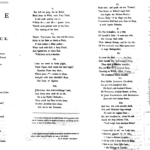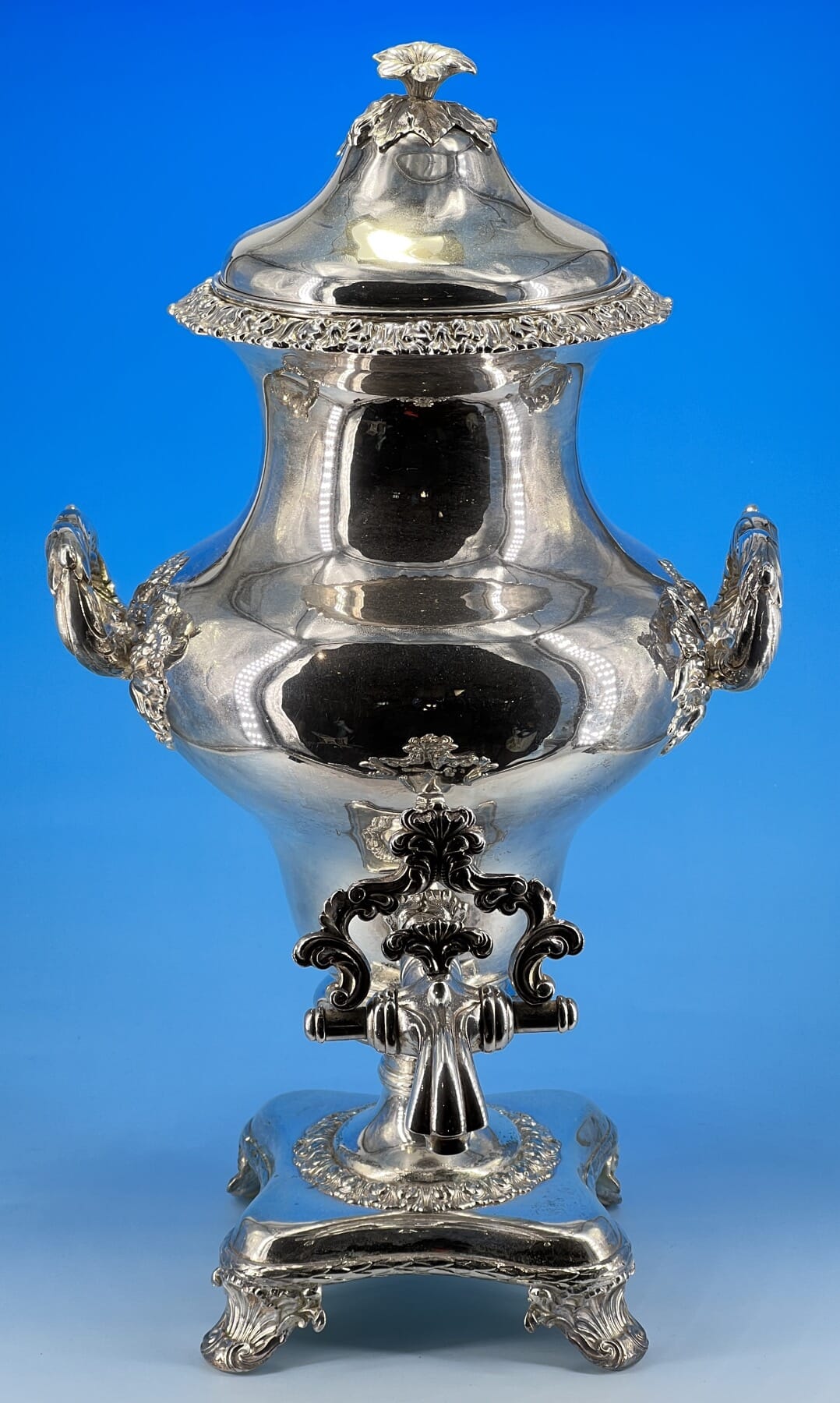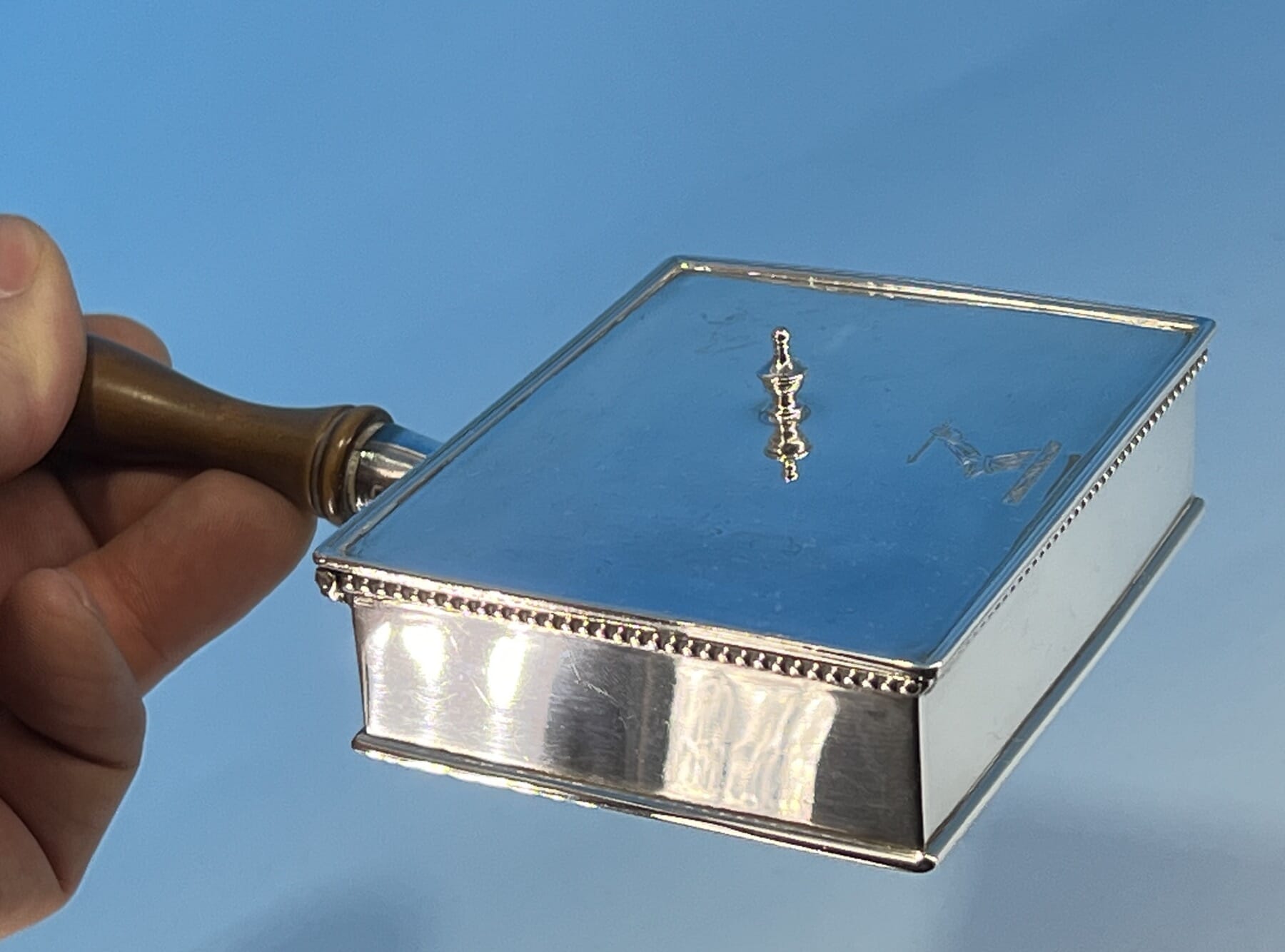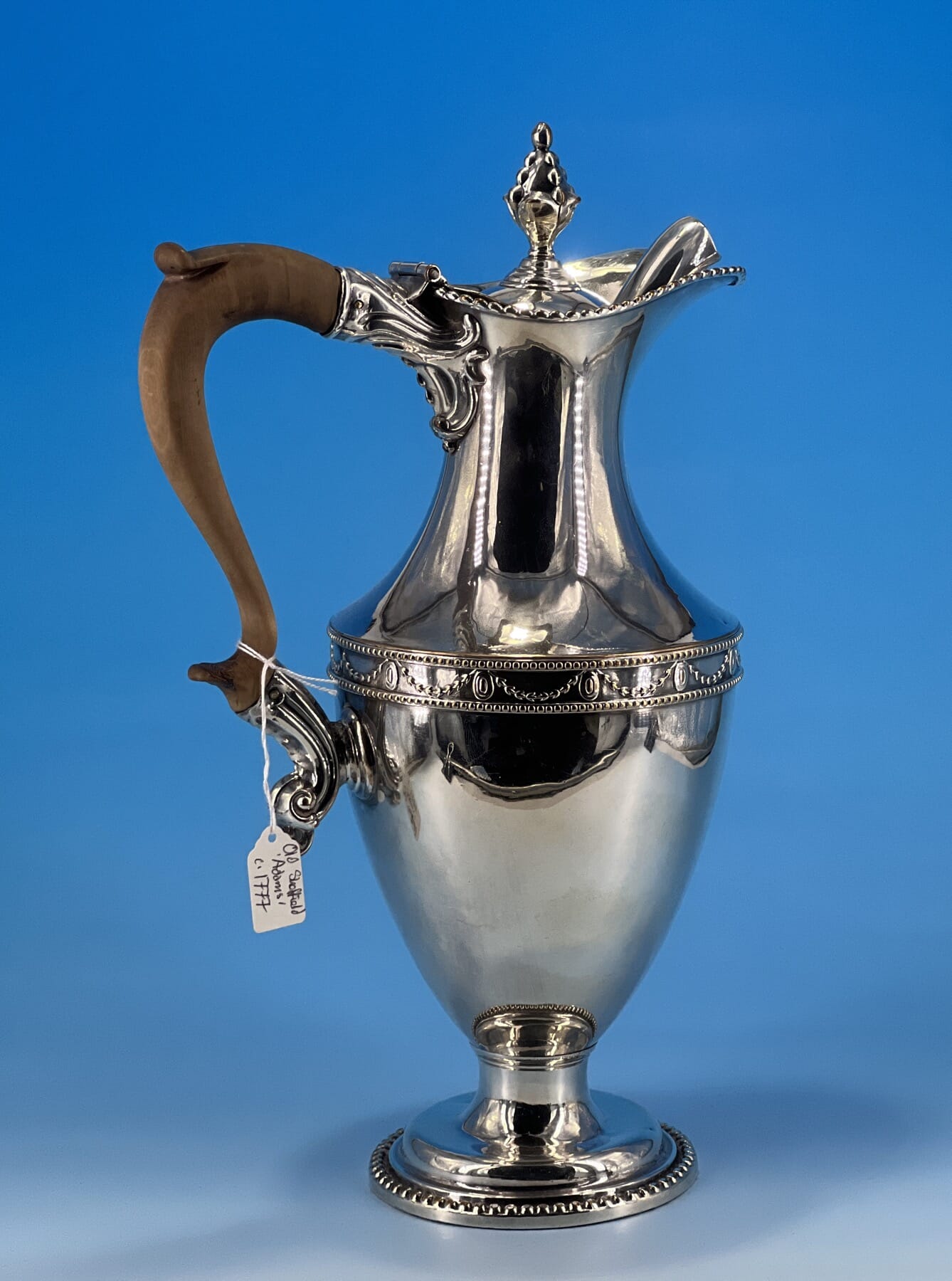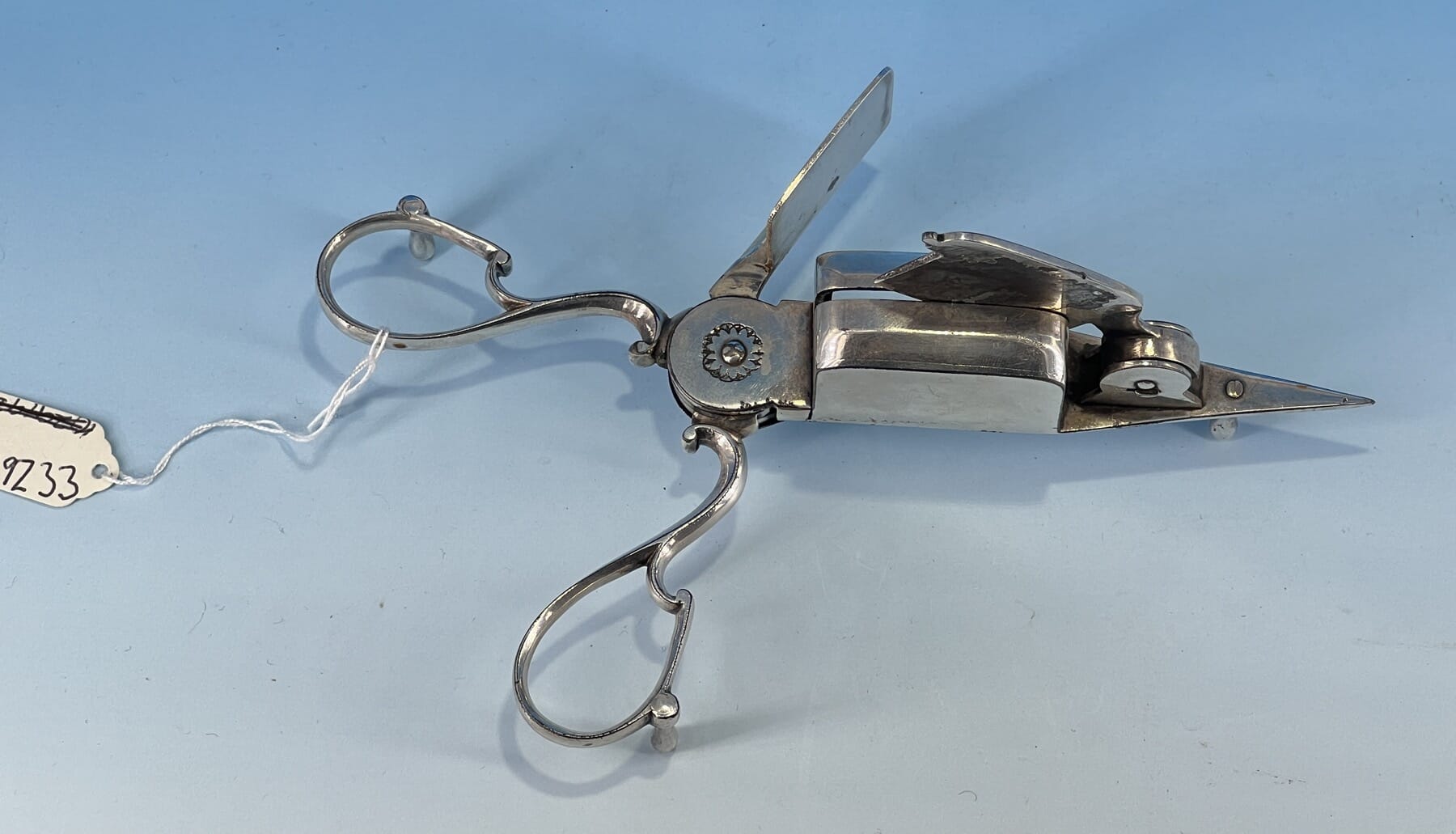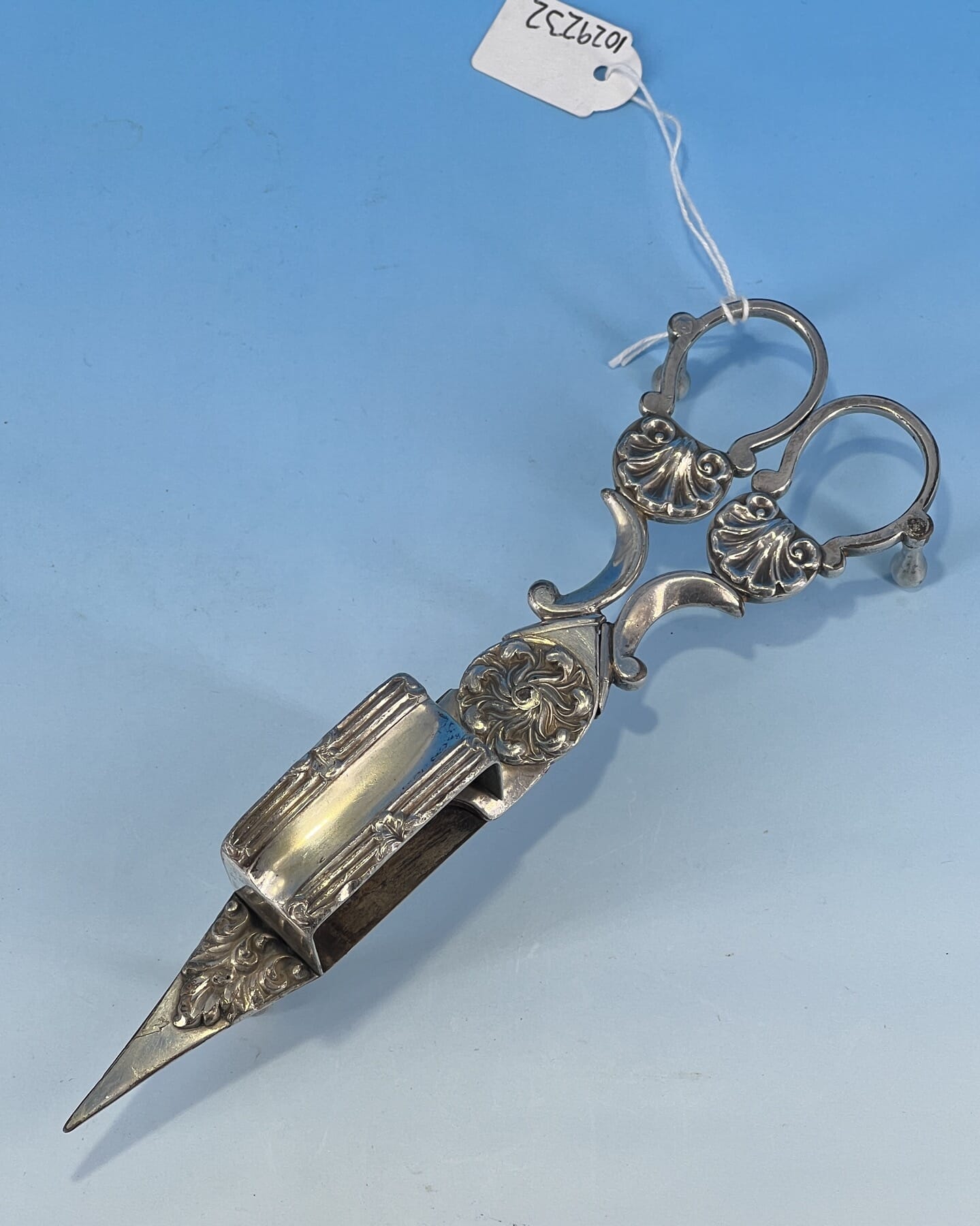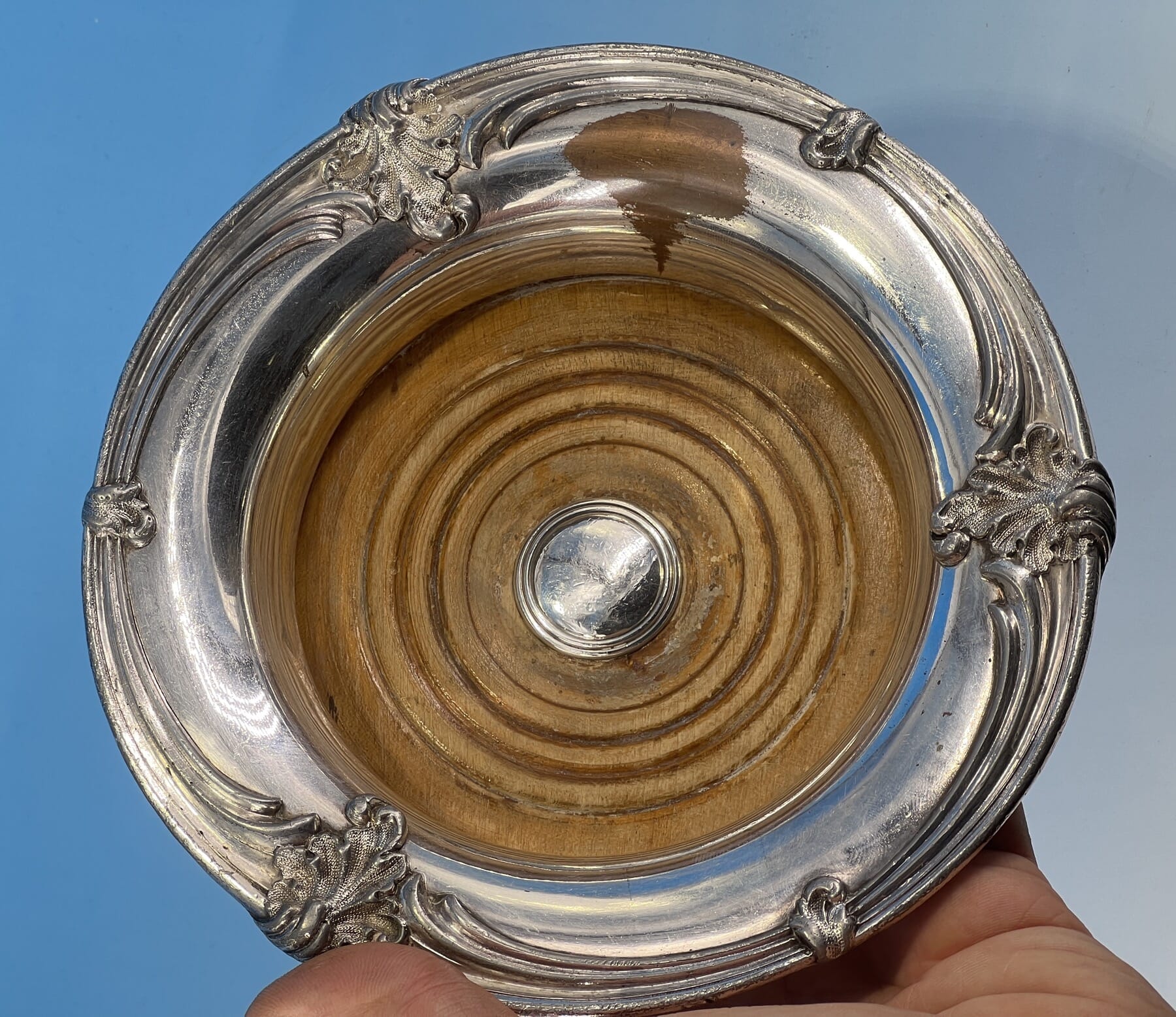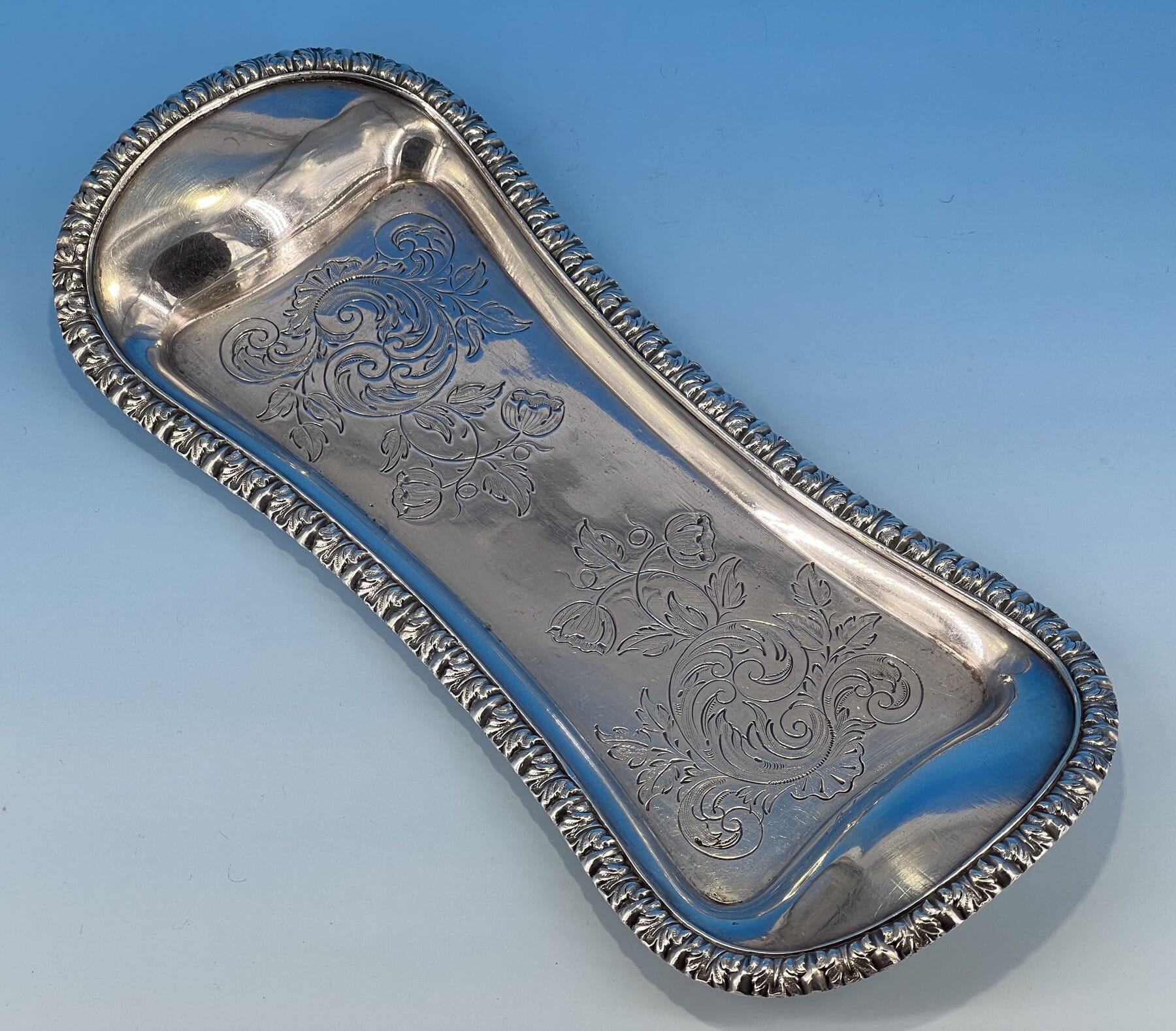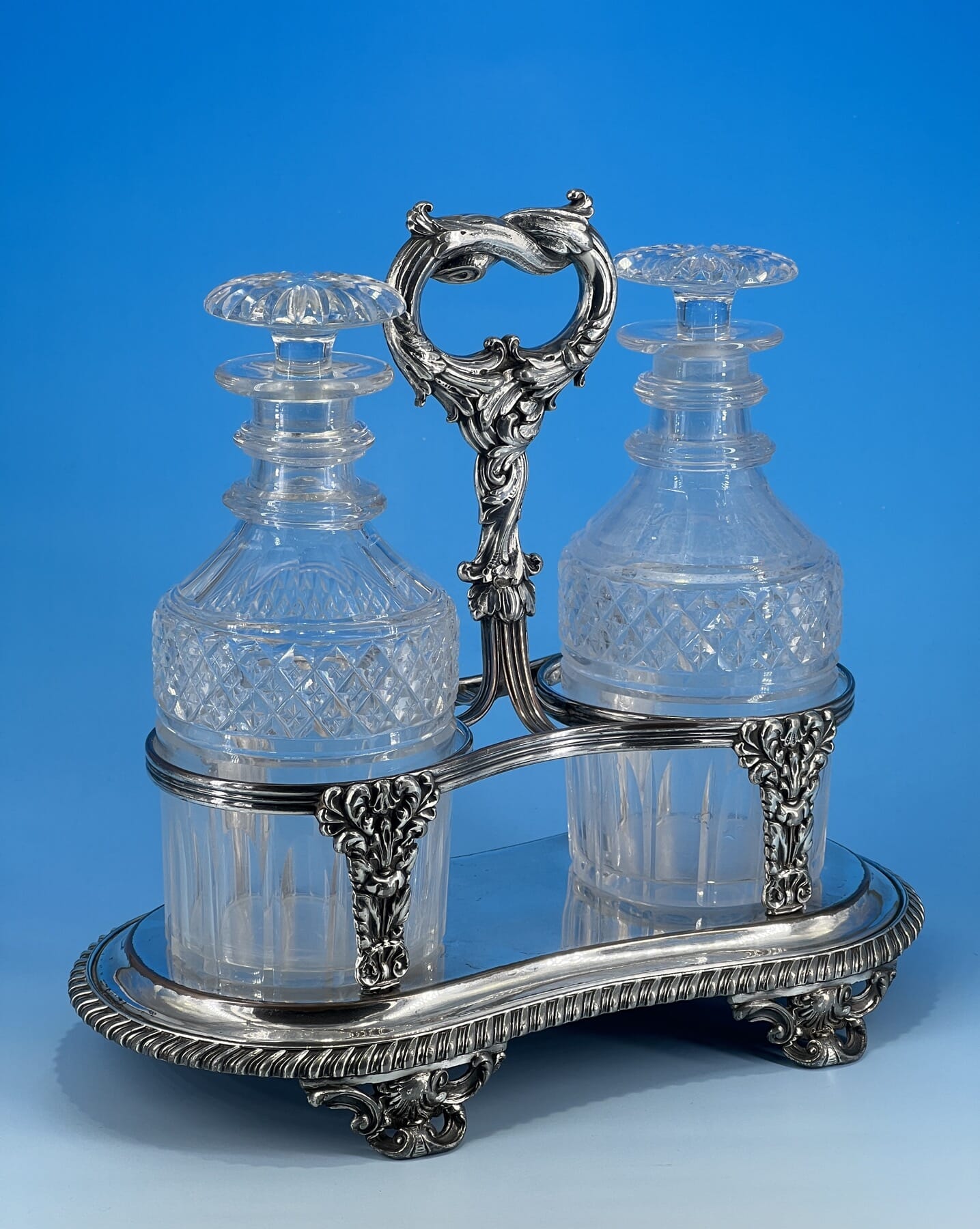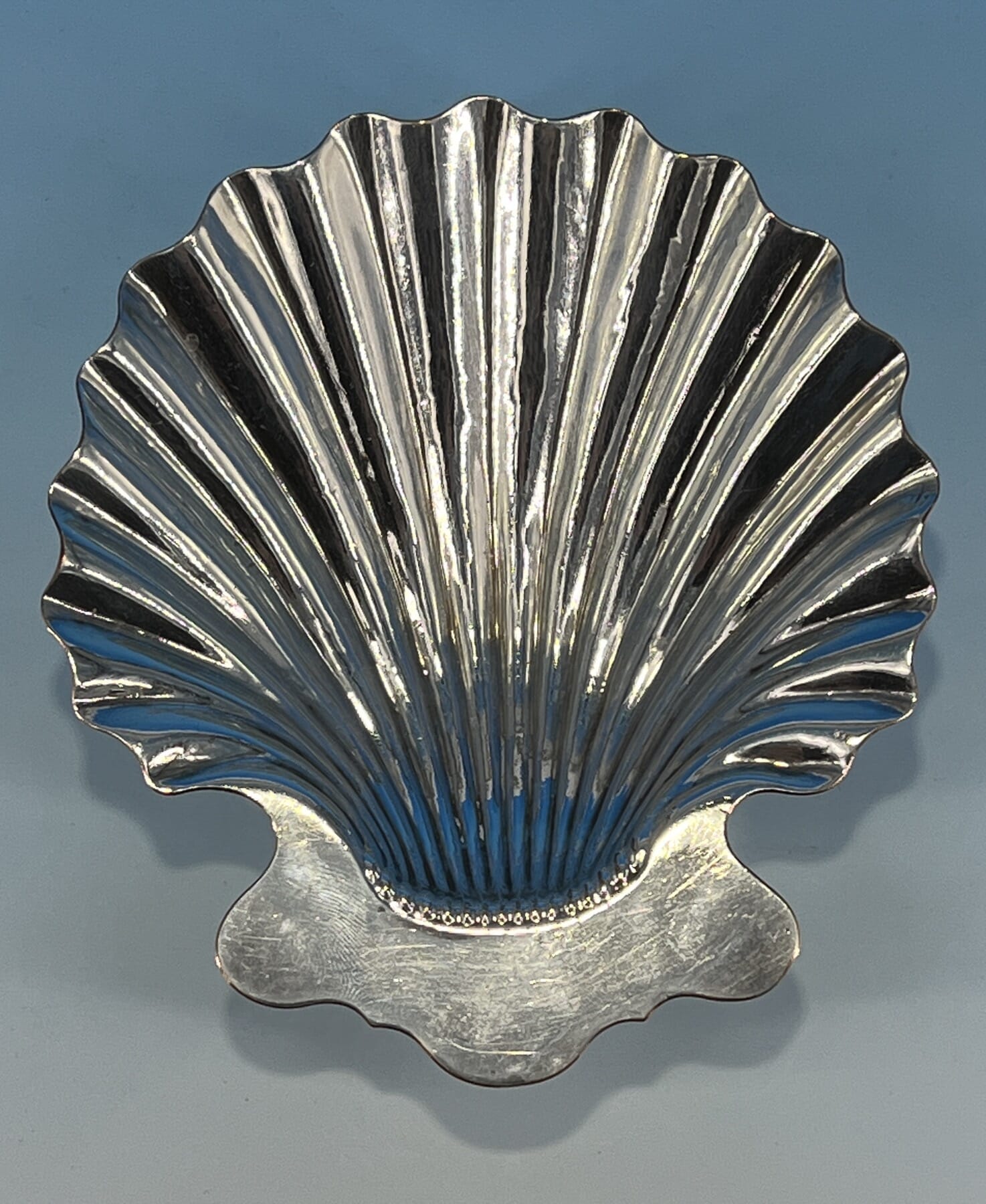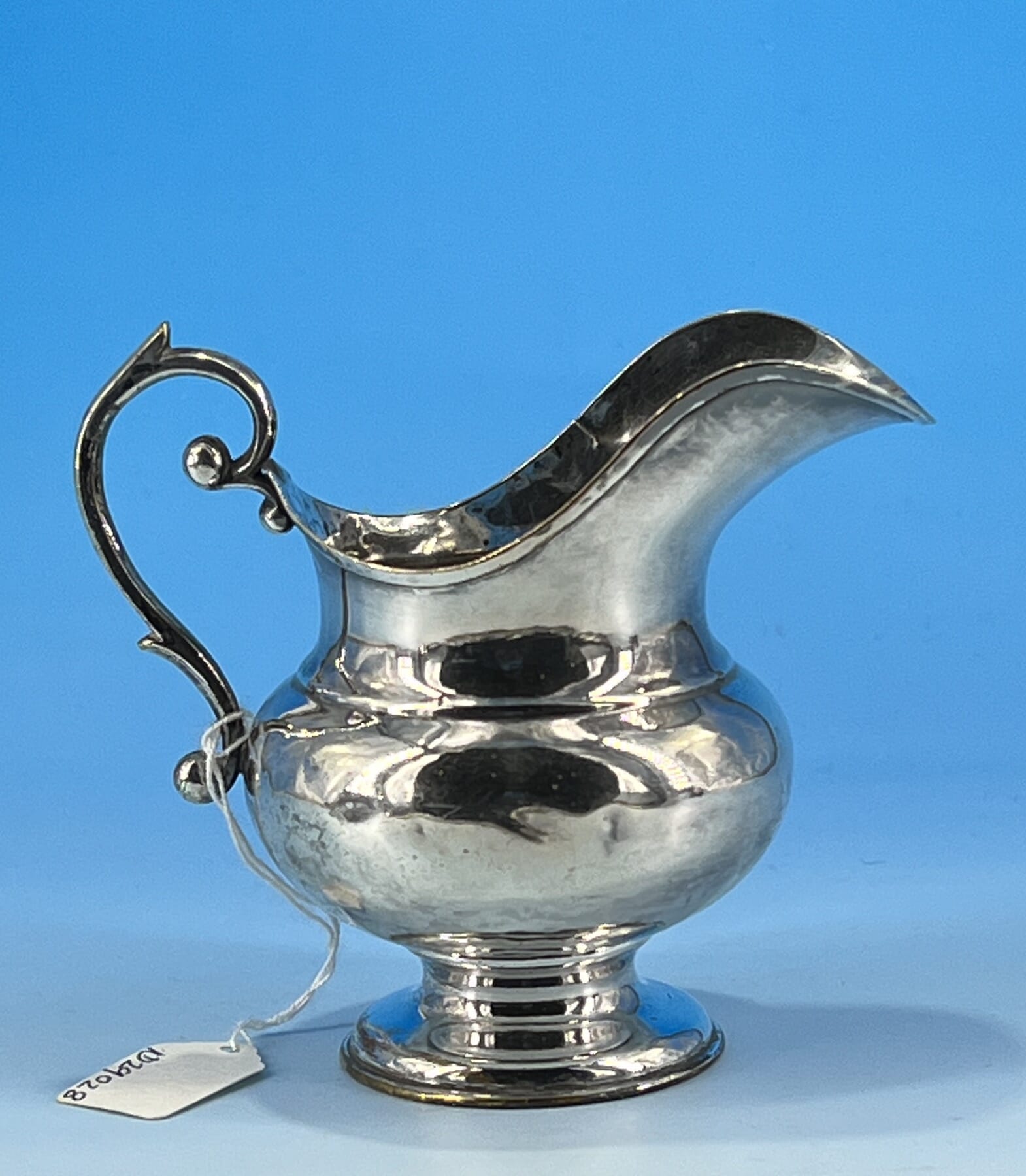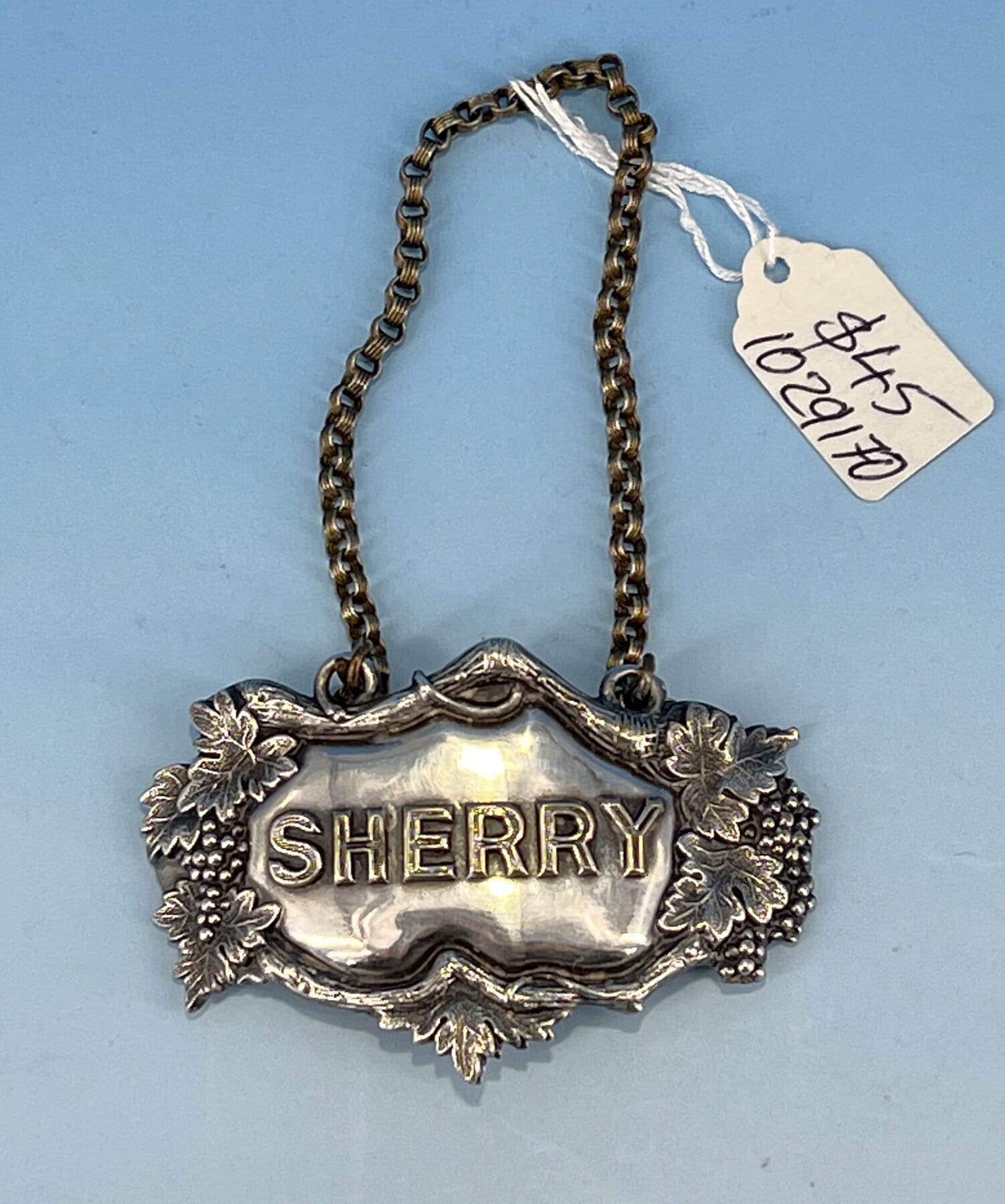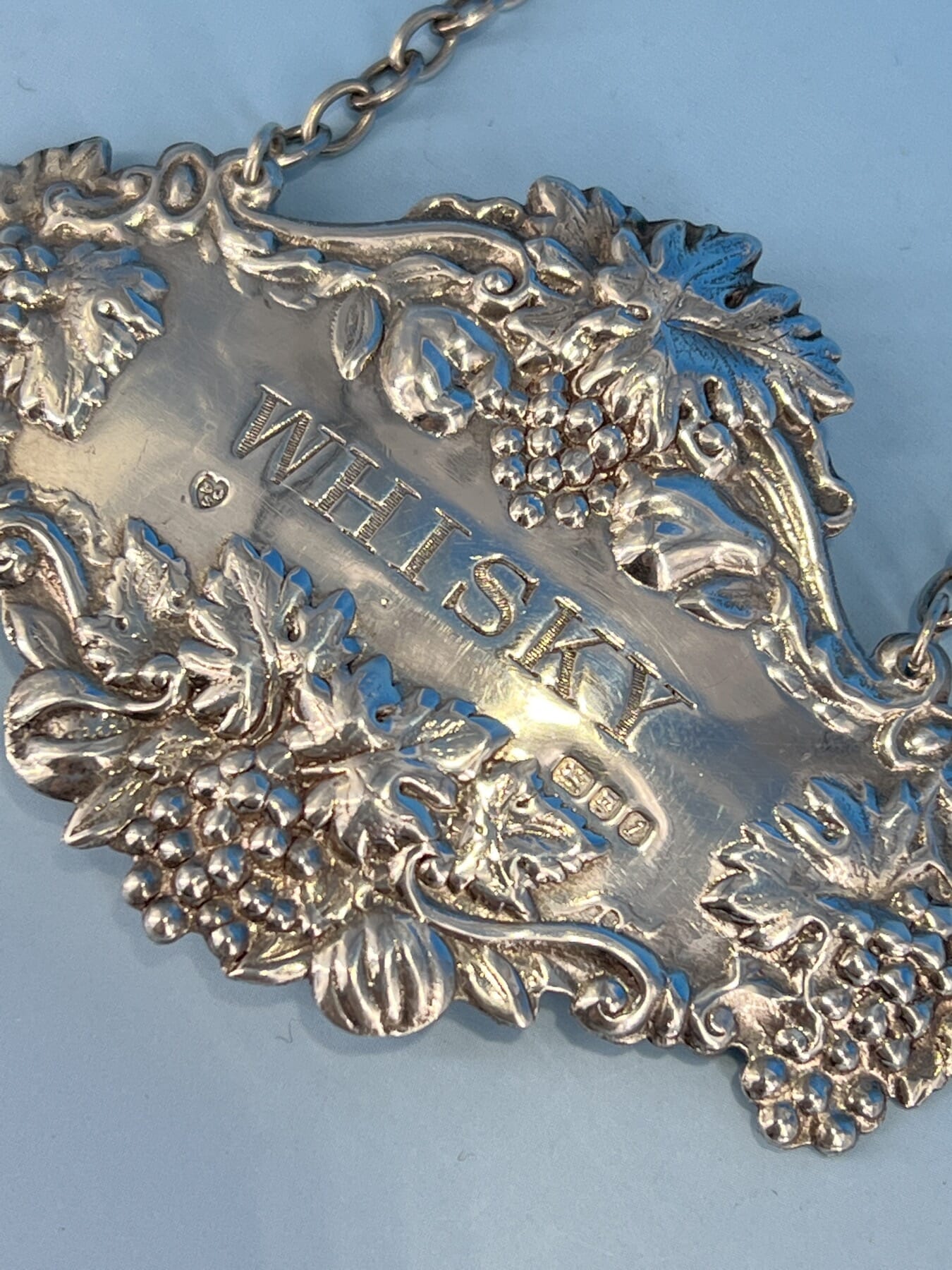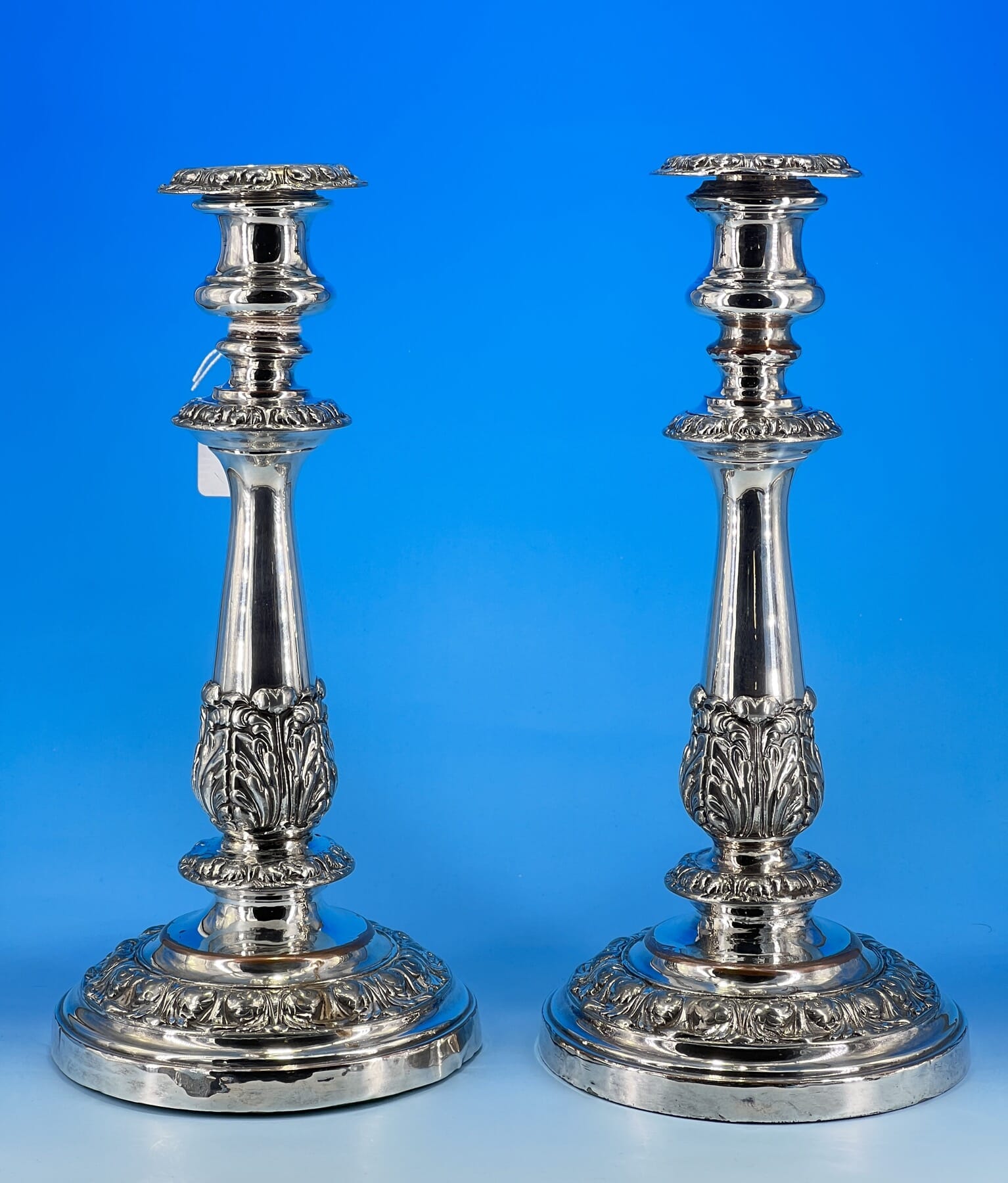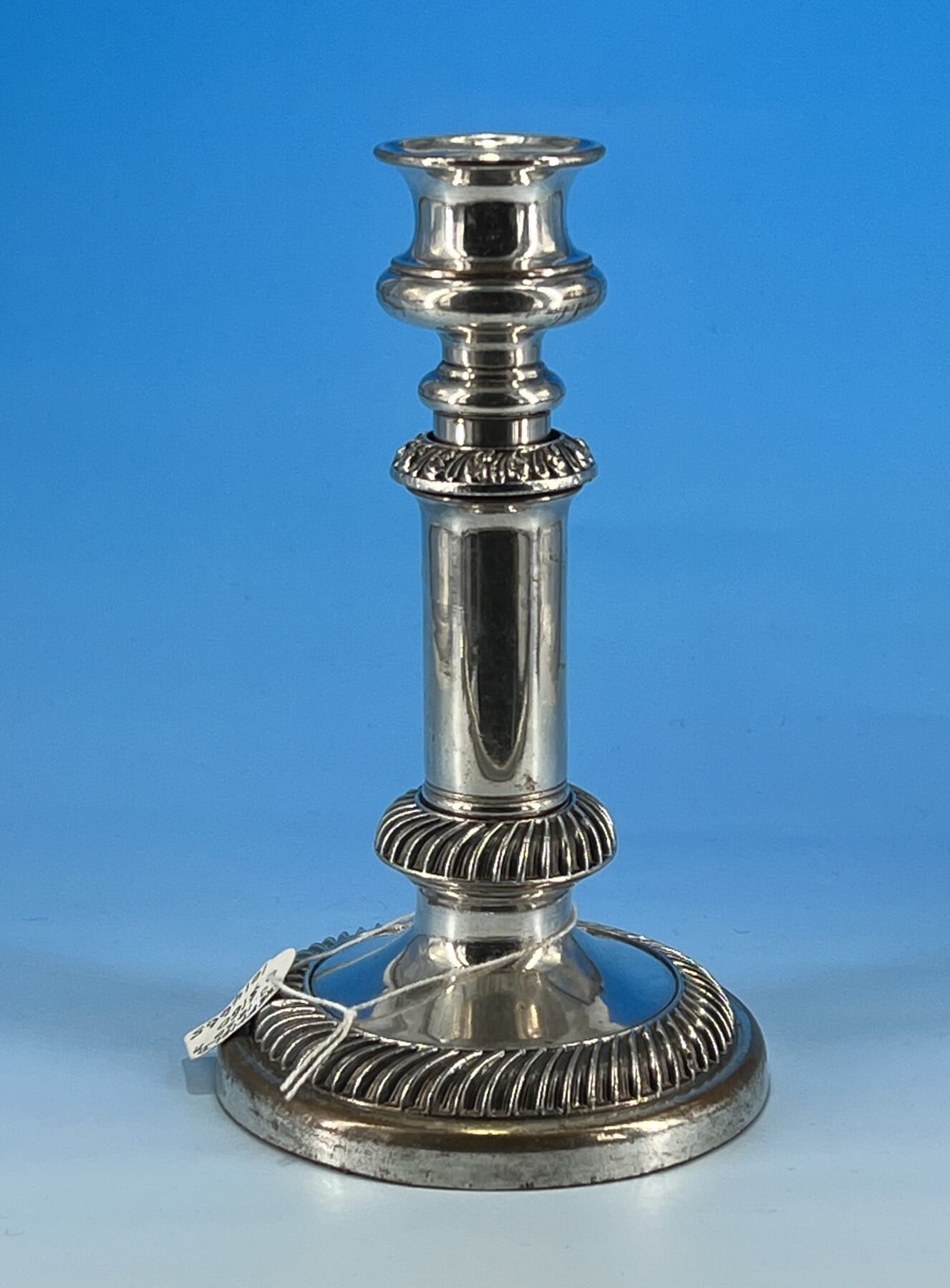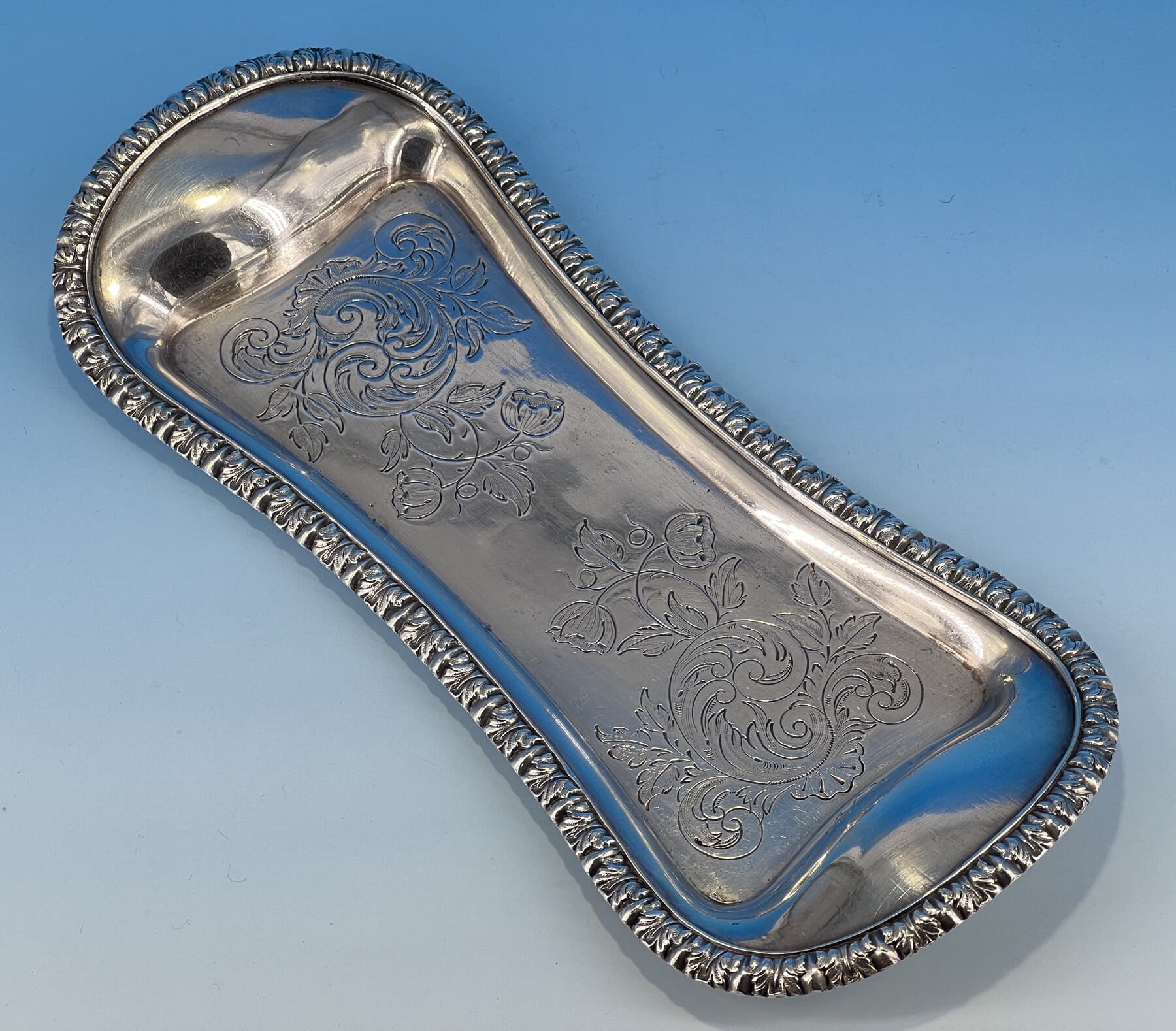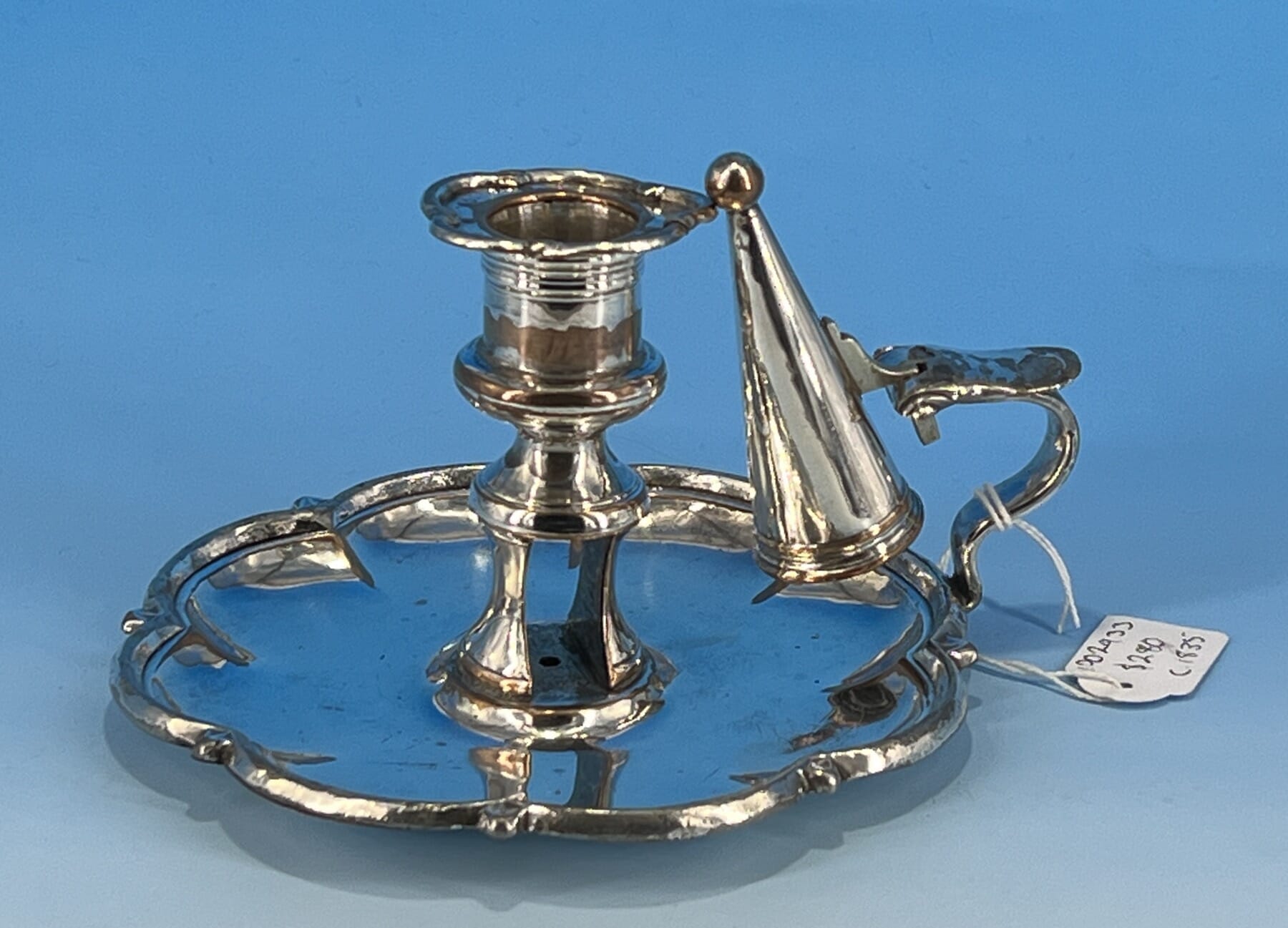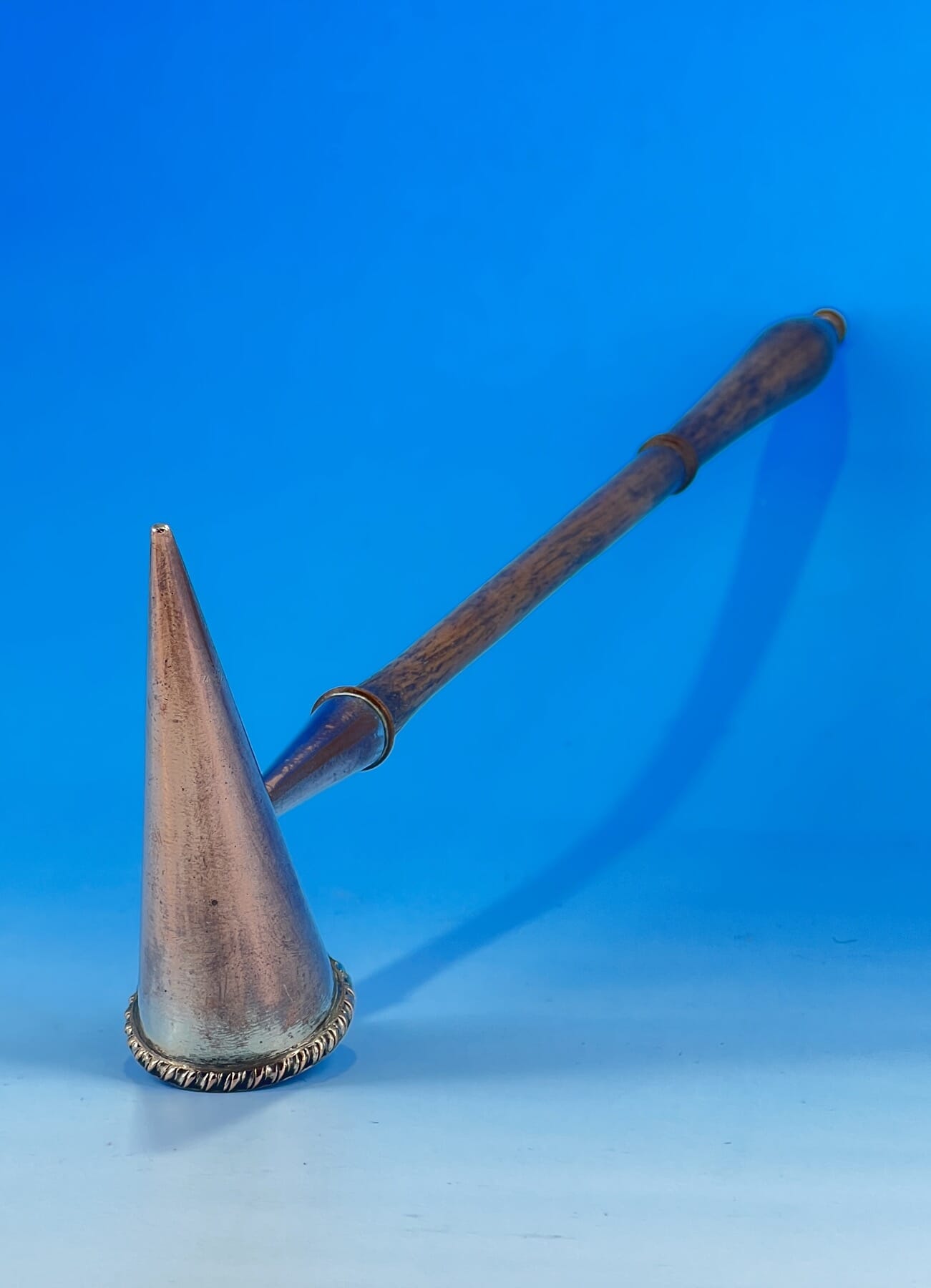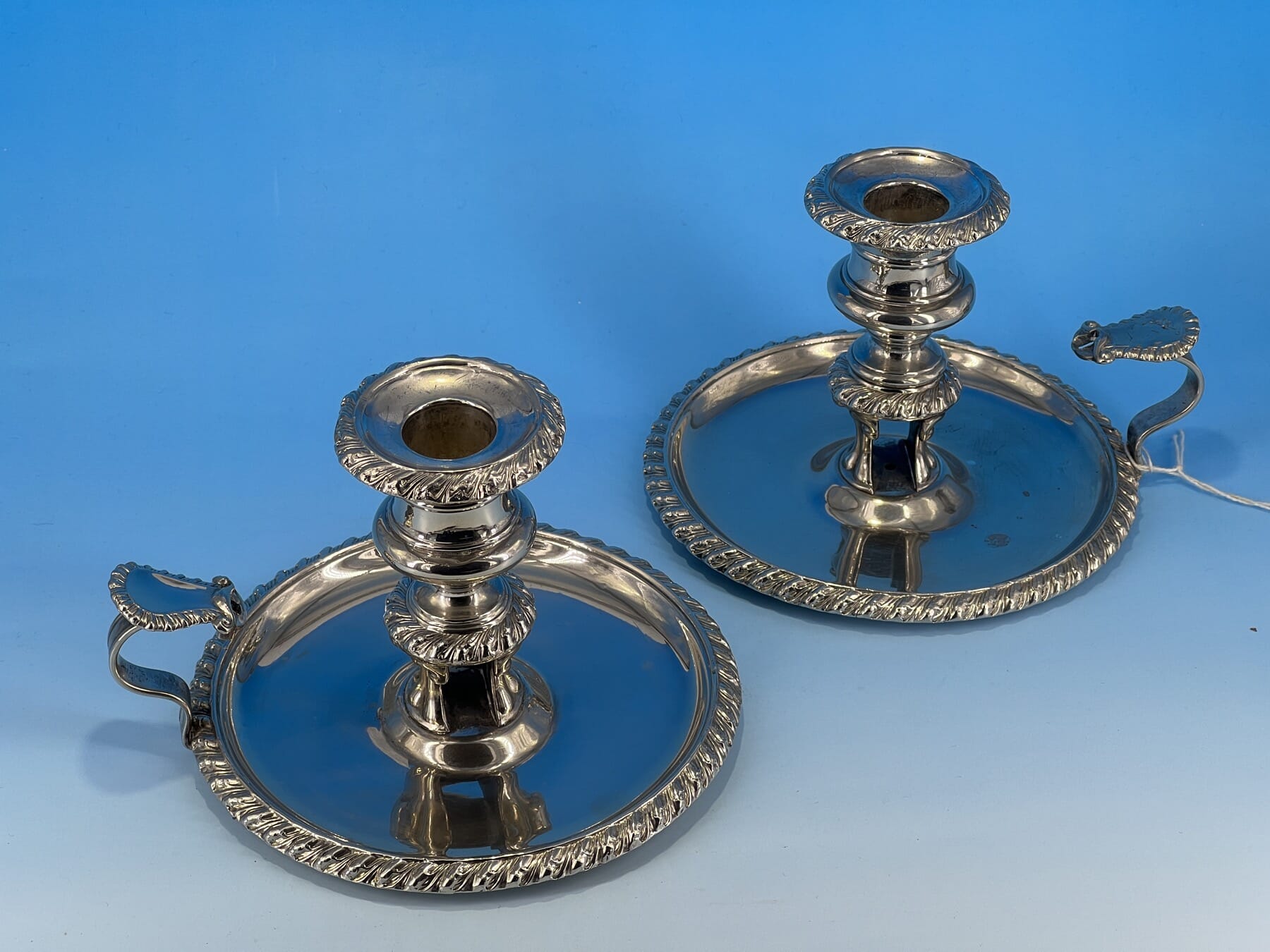

23rd March 2022
Today’s ‘Fresh Stock’ additions are mostly classic pieces of ‘Old Sheffield Plate’ – with a few Sterling Silver and a few Plated pieces mixed in.

Old Sheffield Plate was of course the method developed in the 18th century to cut down on the amount of silver used in tablewares. It did, however, increase the amount of time & care needed to make the pieces, as they are all laboriously put together from a flat rolled sheet of silver & copper.
Of particular note is the Old Sheffield claret jug. This is an absolute rarity; the coffee pots we featured a while ago are not common, but a claret is magnitudes rarer.
In ‘The History of Old Sheffield Plate (published 1912), Bradbury’s definitive book on the subject, he illustrates the identical claret jug (p.308). This is captioned as a “1 1/2 pint Adam jug, by Mathew Fenton & Co. Date 1777”.
He then describes these jugs as “By no means the least useful, and certainly the most graceful…” of the Old Sheffield products. He refers to them as ‘Claret jugs’, stating they are ‘very rarely to be met with to-day’ (in 1912). In 2022, it’s even more so – especially in the excellent condition we have found this one in.
The attribution to Mathew Fenton & Co. via Bradbury’s illustration is firm, with only a couple of minor differences; the junction of the foot & body in ours has a seam, while the engraved illustration is smooth, and the handle – hand-carved from boxwood- has an extra protruding spur at the base.
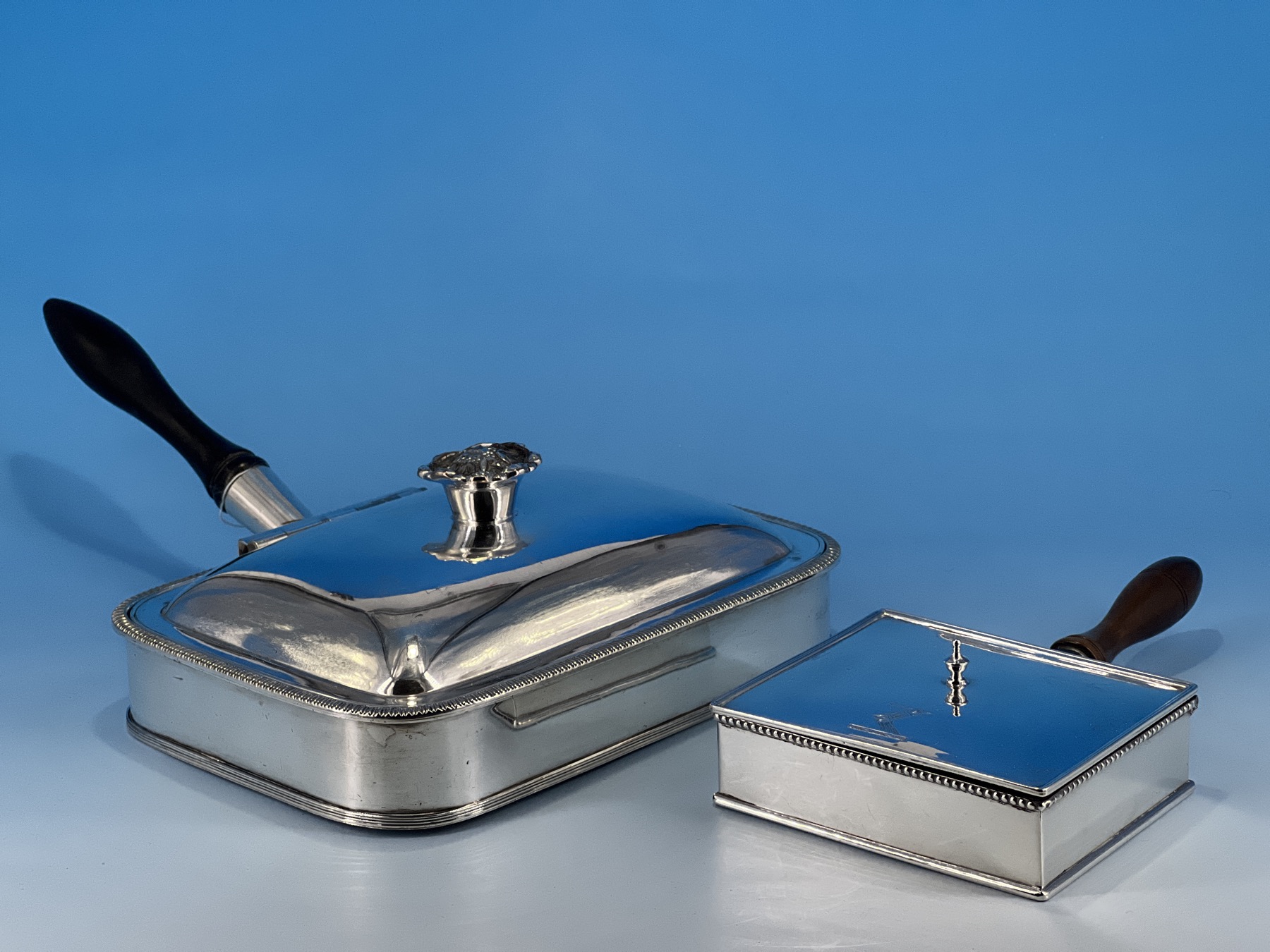
Other interesting pieces include two ‘Cheese Toasters’. The toasted bread was placed inside with the cheese ready on top; the enclosed shape, when heated, would to a good job of melting the cheese, something that has never gone out of fashion! These small single-handled dishes were popular in the late 18th – early 19th century, and one has the very smart hi-tech feature of a ‘warming compartment’. This is hidden beneath the interior, and accessed by unscrewing the wooden handle.


The thread then makes a water-tight seal, and his Lordship’s cheese is guaranteed to be nice & runny…. it bears the crest of an arm with an arrow, but as this was applied to dozens of families armourials, it is impossible to be specific about who had their cheese from this dish.
The smaller armorial piece does, however, have a rare makers mark, and this allows us to identify the workshop of T&J Creswick, Sheffield.
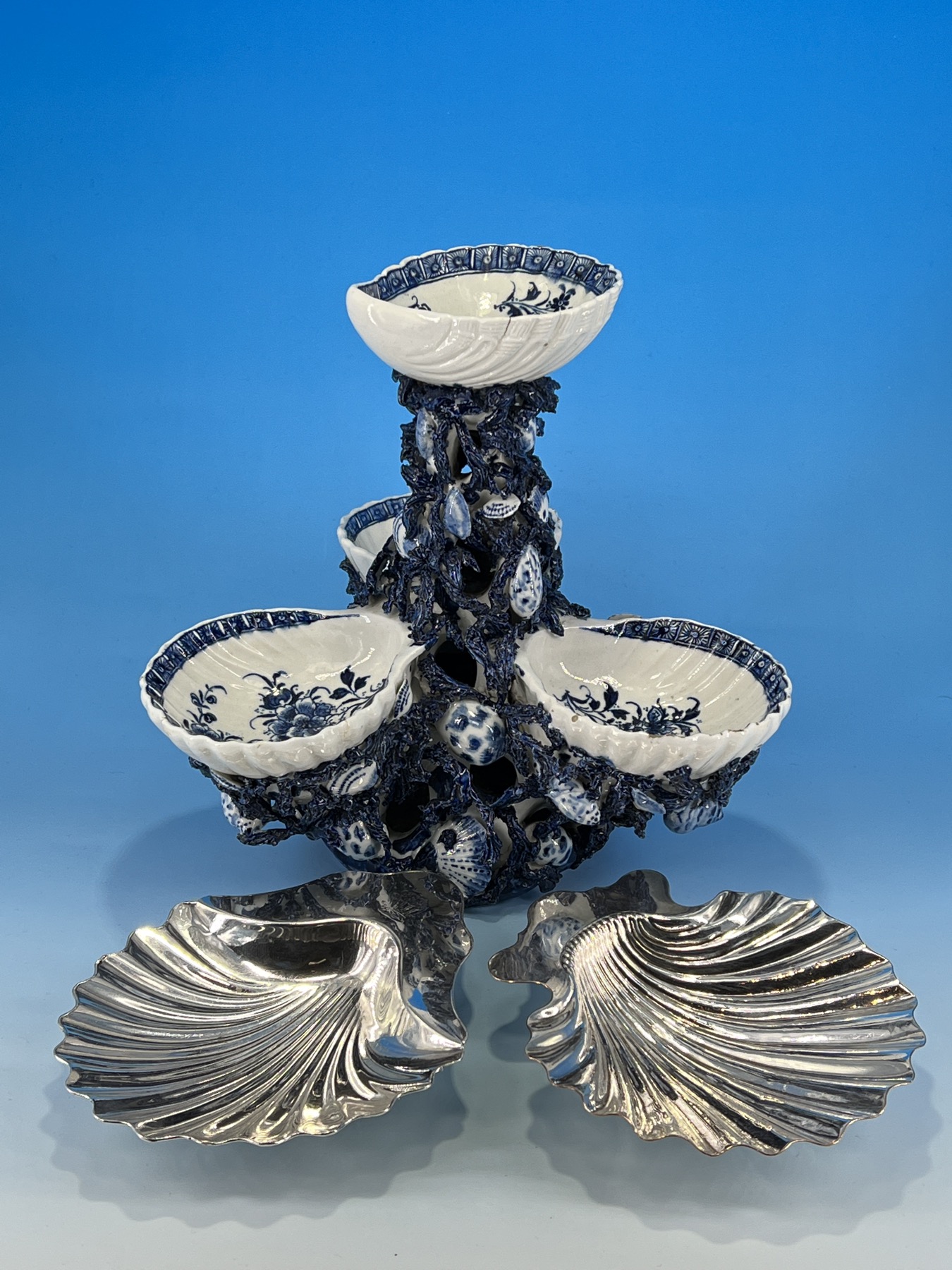
An elegant couple of items are the Old Sheffield shell-form dishes. These are often seen in porcelain, where they are called ‘pickle dishes’, the idea being they were used on the table to serve pickled garnishes necessary to disguise the dubious preservation of any meat served, a necessity until the invention of reliable refrigeration.
However, silver finished items would not be very useful with an acid-like pickle vinegar placed in them – they would tarnish before your eyes. These dishes must have been used for something else on the tables of the gentry, perhaps for the sweetmeats of the desert setting. There are large ‘towers’ of shells in porcelain from Derby Worcester and Bow from the 18th century which are described as being dessert / sweetmeat stands, so it is logical these were used in the same manner.

Some interesting pieces of history are the ‘candle snuffers’. Shaped like scissors, they have a rectangular box one arm, the lid on the other. Despite their name, they were not to ‘snuff’ the candle out; rather, they fulfilled a very important job in the world of illumination: when the wick of the candle burnt lower and left a charred remnant, it would cause problems with the flame, smoke a lot, and could melt the candle to one side and cause an unwanted loss of molten wax. It was important then to trim the wick; a householder would take pride in being able to use a pair of these scissors with the box incorporated to carefully slice the old burnt portion from the top of the wick, leaving it to still burn & illuminate below. The wick would be ‘snuffed’ in the metallic box, and cease to smoke; it could then be disposed of later, as once placed on the handy snuffer-tray it could be taken away by your servants to be disposed of once you were finished for the evening.

A particularly interesting pair can be traced to a 1776 patent by Christopher Pinchbeck, a London clock maker. His story is fascinating, a worthy subject of another blog post; his design both snuffed the offcut wick, and through the use of a levered ‘gate’, held the offensive black remnant securely. The snuffers above follow the design of his 1776 patent drawing closely, which he described as follows:
Pinchbeck’s 1776 Patent application.
‘Some additions to those very useful domestic machines, called snuffers, by which those disagreeable circumstance of them dropping the wick after snuffing the candles, so generally complained of, is totally prevented’.




Searching for examples online I was amused to find an ‘Ode to Pinchbeck’s Candle Snuffers’ – penned by “Malcolm McGreggor” – the pseudonym of political satirist William Mason – in 1776. This was of course the year of the American Revolution, and it is a direct attack on the sad state of affairs with the British smarting from the loss of their American colonies. So, the author calls on the latest high-tech invention to solve the problem:
‘Illustrious Pinchbeck I condescend,
Thou well beloved, and best King’s friend;
These Lyric lines to view.
Oh! may they prompt thee, e’re too late,
To snuff the candle of the State,
That burns a little Blue….
1776 ‘Malcom McGreggor’
It continues in this vein, bringing in the characters associated with the American Revolution, and suggesting that a very large snuffer could be the solution – to completely snuff out the pesky Rebels like Washington!
The deed is done, thy foes are dead,
No longer England shalt thou dread,
such Presbyterean Huffers;
Thy candle’s radiance ne’er shall fade,
with now & then a little aid,
from Pinchbeck’s Patent Snuffers!
1776 ‘Malcom McGreggor’
(If you’re curious, I have copied the original pamphlet onto a single page here – click to enlarge).

Finally, to find your way to bed through the darkened house, there was the chamberstick; these candlesticks are low and broad, giving the safest possible configuration to guard against the very real danger of accidental ignition of the furnishings. The handle and thumbpiece gives an excellent grip, and our example here has the original cone-shape snuffer, nice & handy to completely extinguish the flame when time came to sleep.
Enjoy!
Paul & Glenys Rosenberg
Mathew Bugg

In other news….
We’re preparing a stunning Exhibition featuring several well established collections of early British & Continental Ceramics.
Date to be defined once the Australian Government settles on a definite date for the upcoming election, as we do not wish to compete for attention on the same day!
Featuring: Bow, Chelsea, Derby, Worcester, Isleworth, James Giles (on Chinese Porcelain), Swansea, Nantgarw, Spode, Newhall, etc. etc….. over 100 choice pieces to tempt.
A ‘Preview’ gallery will be accessible on our website shortly, keep your eye out for an upcoming email announcement.
Today’s Old Sheffield ‘Fresh Stock’
-
 Early Silver Plate samovar, Wright’s Patent, circa 1845$1,450.00 AUD
Early Silver Plate samovar, Wright’s Patent, circa 1845$1,450.00 AUD -
 Old Sheffield Plate ‘toasting box’, c. 1815Sold
Old Sheffield Plate ‘toasting box’, c. 1815Sold -
 Old Sheffield Plate ‘Adams’ style claret Jug, Mathew Fenton & Co c.1777Sold
Old Sheffield Plate ‘Adams’ style claret Jug, Mathew Fenton & Co c.1777Sold -
 Close Plate steel candle snuffers with patented retracting mechanism, c.1780$245.00 AUD
Close Plate steel candle snuffers with patented retracting mechanism, c.1780$245.00 AUD -
 Close Plate Steel candle snuffers with spring loaded hinge, c.1820$185.00 AUD
Close Plate Steel candle snuffers with spring loaded hinge, c.1820$185.00 AUD -
 Old Sheffield Plate wine coaster with concave sides and wooden base, c.1830$195.00 AUD
Old Sheffield Plate wine coaster with concave sides and wooden base, c.1830$195.00 AUD -
 Old Sheffield Plate snuffer tray with engraved flowers, c.1820$195.00 AUD
Old Sheffield Plate snuffer tray with engraved flowers, c.1820$195.00 AUD -
 Old Sheffield Plate double cruet with Georgian decanters, c. 1825$1,250.00 AUD
Old Sheffield Plate double cruet with Georgian decanters, c. 1825$1,250.00 AUD -
 Old Sheffield Plate hot cheese toasting dish, c. 1815$395.00 AUD
Old Sheffield Plate hot cheese toasting dish, c. 1815$395.00 AUD -
 Old Sheffield Plate scallop shape dish, c. 1800Sold
Old Sheffield Plate scallop shape dish, c. 1800Sold -
 Old Sheffield Plate scallop shape dish with crest, c. 1800Sold
Old Sheffield Plate scallop shape dish with crest, c. 1800Sold -
 Old Sheffield Plate circular tobacco box, c. 1805$285.00 AUD
Old Sheffield Plate circular tobacco box, c. 1805$285.00 AUD -
 French close-plate helmet shape milk jug, c. 1800$265.00 AUD
French close-plate helmet shape milk jug, c. 1800$265.00 AUD -
 Victorian plated decanter label ‘Sherry’, with vine moulding, c. 1890$45.00 AUD
Victorian plated decanter label ‘Sherry’, with vine moulding, c. 1890$45.00 AUD -
 Sterling ‘Sherry’ decanter label with shell & scroll border, London 1967Sold
Sterling ‘Sherry’ decanter label with shell & scroll border, London 1967Sold -
 Sterling decanter label, ‘Whiskey’, fruiting vine border, London 1966Sold
Sterling decanter label, ‘Whiskey’, fruiting vine border, London 1966Sold -
 Old Sheffield Plate pair of candlesticks of generous size, C. 1820$950.00 AUD
Old Sheffield Plate pair of candlesticks of generous size, C. 1820$950.00 AUD -
 Old Sheffield Plate telescopic candlestick with gadrooned edges, c.1820$160.00 AUD
Old Sheffield Plate telescopic candlestick with gadrooned edges, c.1820$160.00 AUD -
 Old Sheffield Plate wine coaster, fruiting vine engraving, c. 1820$280.00 AUD
Old Sheffield Plate wine coaster, fruiting vine engraving, c. 1820$280.00 AUD -
 Old Sheffield Plate snuffer tray with gadrooned edge, c.1815$150.00 AUD
Old Sheffield Plate snuffer tray with gadrooned edge, c.1815$150.00 AUD -
 Old Sheffield Plate lobed chamberstick with snuffer, C. 1835Sold
Old Sheffield Plate lobed chamberstick with snuffer, C. 1835Sold -
 Old Sheffield Plate extinguisher, c.1800.$480.00 AUD
Old Sheffield Plate extinguisher, c.1800.$480.00 AUD -
 Pair of Old Sheffield Plate chambersticks with intricate gadrooned endges, C. 1820$340.00 AUD
Pair of Old Sheffield Plate chambersticks with intricate gadrooned endges, C. 1820$340.00 AUD

